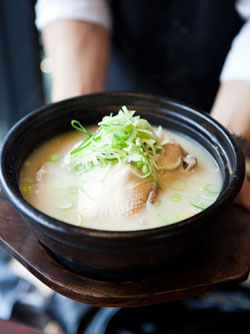 Stuffed and sated without the ability to eat even one more bite – or so I thought – we headed to Hwang Hu Sam Gye Tang restaurant to experience Samgyetang, a hot bowl of bubbling chicken soup made with one very important ingredient: ginseng.
Stuffed and sated without the ability to eat even one more bite – or so I thought – we headed to Hwang Hu Sam Gye Tang restaurant to experience Samgyetang, a hot bowl of bubbling chicken soup made with one very important ingredient: ginseng.
Ushered upstairs to the second floor of this elegant and glistening airy restaurant, we were seated next to a vast window overlooking a rainy busy side street below. We passed walls that were lined with photographs of celebrity and everyday patrons, leaving the menu to appear even that much more sparse. Hwang Hu Sam Gye Tang doesn’t offer too many things other than chicken and ginseng soup, a fact I’d later forget about once the scorching hot liquid touched my tongue.
The chef and host suggested that they bring our food to the table before cooking purely for photographic purposes. “Please, do not go through any trouble” I said to our guide, watching my translated words make their way to the chef. The chef wouldn’t have it any other way, his face said everything I needed to know. Once a boiling hot soup is brought to our table I would see none of the ingredients; steam and bubbles would make sure of that. I acquiesced and like a good guest I let them set out bowls of food to photograph.
A traditional Korean cast iron bowl was set before me and my camera, filled with a straw-colored pale broth and strips of green leeks resting on top of stark white chicken, skin attached. The bowl of soup clearly doubled as an optical illusion. Inside the innocuous yellow liquid would be the flavor of a thousand chicken soups, purely a contradiction to a person who always thought soup needs to be dark, unctuous and forever cooked to coax out such rich flavors.
 The uncooked soup bowl was returned to the kitchen to be cooked as we drank beer and had a quick lesson in pronunciation. When the soup made its way back to the table it was alive and bubbling with frenetic energy, leaving me to wonder if Koreans are the only people on the planet that put their tongues in such obvious jeopardy. “Wimp,” I muttered to myself as I used a spoon to cut open the young tender chicken to reveal the jujube and tender chestnut that had been cooked inside the bird. As I broke the chicken apart I noticed my hand became wet with steam at the same time the smell of the soup reached my nose. Earthy. Hot. Ginsengy. But not in a walked-into-a-dusty-medicine-shop kind of way; rather an exciting, fragrant, tasty kind of way that reinvigorated my appetite almost immediately.
The uncooked soup bowl was returned to the kitchen to be cooked as we drank beer and had a quick lesson in pronunciation. When the soup made its way back to the table it was alive and bubbling with frenetic energy, leaving me to wonder if Koreans are the only people on the planet that put their tongues in such obvious jeopardy. “Wimp,” I muttered to myself as I used a spoon to cut open the young tender chicken to reveal the jujube and tender chestnut that had been cooked inside the bird. As I broke the chicken apart I noticed my hand became wet with steam at the same time the smell of the soup reached my nose. Earthy. Hot. Ginsengy. But not in a walked-into-a-dusty-medicine-shop kind of way; rather an exciting, fragrant, tasty kind of way that reinvigorated my appetite almost immediately.
I have never loved chicken soup, mothers and folklore be damned. Too thin for my tastes, the idea of clear broth cooking rubbery chicken with swollen skin never appealed to me. Where was the char, the crunch, the browning, the culinary processes that occur in other stews, soups, and braises I adore so much? Besides, if we are to enjoy a soup when we are feeble and infirmed then what does this say about the soup? Exactly.
Samgyetang was bubbling in front of me, provoking me to change my mind about chicken soup. It succeeded. It was exciting, rich, layered with flavor and depth I’ve never experienced from a pale broth. To eat it you’d pluck pieces of chicken out of the atomic caldron and place in a small individual bowl, topping with broth and a sprinkle of coarse salt. My notions of chicken soup disappeared as I placed the empty bones into a small container. The cooked jujube, eaten with broth, reminded me of prunes slow roasted with chicken, the chestnut lent a potato-y taste and texture as well. The chicken? It couldn’t have been better– tender and beyond delicious. The entire dish was exotic and Asian while simultaneously familiar and perfect. I continued to slurp and eat this tender white chicken and leeks, my mouth happily filled with ginseng broth, until there was no more left. I could have easily done it over and over again.
Matt Armendariz is a writer and photographer who lives in Los Angeles and chronicles his passion for food and travel on his blog MattBites. His latest book is "On a Stick!"


